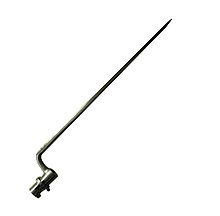Spike bayonet

A spike bayonet, also known as a pigsticker in informal contexts, is a blade attachment for a firearm taking the form of a pointed spike rather than a knife.
Description
Most early musket bayonets were of this type. From around 1800 knife- or sword-style bayonets began to appear, which could also be wielded by hand. In the early 20th century spike bayonets reappeared, often folding or stowed under the barrel for compactness, such as on the French MAS-36, Chinese SKS and German FG 42. The spike bayonet was also used on the Russian Mosin–Nagant. The Lee–Enfield No.4 bayonet or Pig-Sticker, was a short spike (but fixed conventionally), and was unpopular due to its length.
Spike bayonets have not been popular with armies since World War II, apart from perhaps China, who attached them to their AK-47 and SKS variants (Type 56 and Type 63), until the introduction of the Type 81 assault rifle, which uses a knife bayonet, in the 1980s. This type of bayonet was the main bayonet used in the American Civil War.
External links
